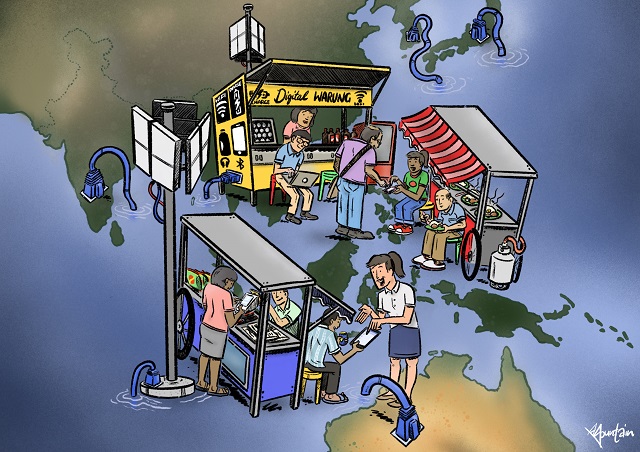
The Covid-19 pandemic has accelerated digital adoption and digital transformation in many regions of the world. In Southeast Asia, this has driven unprecedented demand for online services in retail, digital payments, education and health. However, the past two years have shown that not all consumers and businesses have the means to capitalise on pandemic-induced digital transformation opportunities. In fact, the pandemic has caused a widening of the digital divide as communities and businesses must rely on digital tools for their lives and livelihoods, even in the absence of sufficient access and supporting skills.
Specifically, micro-, small and medium enterprises (MSMEs) without the means to adopt digital technologies, such as using e-platforms or engaging in digital transactions, were hard hit by the lockdowns. Women have been similarly disproportionately affected, since many are employed in the informal and ‘gig economy’ sectors. In addition, the pandemic has further exposed more users to cybersecurity and online safety risks in an environment where practices of cyber hygiene are generally poor.
For the many fragile democracies in the Indo-Pacific, this is creating conditions that could undermine democratic resilience. A central question for these governments is how to drive accelerating digital transformation and ICT-enabled growth to reduce poverty, support sustainable economic growth and build social cohesion while maintaining resilience to cybersecurity threats.
How Southeast Asian governments, in collaboration with industry and civil society, harness their collective strengths and forge new partnerships today will determine the shape of the next phase of their digital transformation.
The digital development, cybersecurity and inclusivity challenges facing Southeast Asian economies are equally relevant for Australia and India.
Over the past few years, India and Australia have been driven more closely together by the Chinese state’s increasingly assertive and disruptive behaviour across several domains, particularly in cyberspace and emerging technologies. New Delhi and Canberra are displaying increasing political willingness to work together on several fronts, including on cyber and technology issues, both bilaterally and within the Quad framework with Japan and the US.
This can also be seen in Southeast Asia, where China’s increasing influence and the geopolitical consequences of its technology push in the region have made India and Australia appreciate the need to engage more proactively with the region across multiple domains, including cyber and critical technologies.
There are ample opportunities for these two emerging technology partners, in collaboration with Southeast Asian nations, to support Southeast Asia’s economic recovery. This community of common interest in a free, open and prosperous Indo-Pacific can, in partnership, strengthen the foundations for an inclusive and thriving digital economy, and provide greater diversity of sources of support for digital development in Southeast Asia.
In our new report, Digital Southeast Asia: opportunities for Australia–India cooperation to support the region in the post-Covid-19 context, jointly produced by ASPI and the Observer Research Foundation, we explore opportunities for common activities that could collectively benefit Southeast Asia, Australia and India. We consider what efforts can be made by an Australia–India collaboration to support Southeast Asia’s digital capacity and resilience and the growth of the Southeast Asian digital economy in the aftermath of the Covid-19 pandemic.
The report finds that the main area of attention when considering the role of digital development in the region’s post-Covid economic recovery is the need to unreservedly address digital skills shortages. Those shortages are particularly pronounced among traditionally under-resourced segments of the economy, such as MSMEs, women and those in non-metropolitan areas.
The report provides recommendations that draw on the strengths and experiences of Australia and India and fall into four areas: streamlining the two governments’ approaches to digital engagement with Southeast Asia; augmenting local efforts to improve the digital and business skills of the regional workforce, with a focus on MSMEs, female digital entrepreneurs and non-metropolitan economic centres; strengthening and deepening policy, resource and experience-sharing relationships with Southeast Asia’s national cybersecurity agencies to improve cybersecurity resilience; and exploring a regional open-source marketplace for public digital infrastructure.

